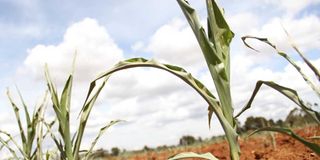Before you vote: the truth about maize harvest predictions

Did experts predict that the maize harvest would not be adequate?
“….Last year, they were told by experts, that because of the weather conditions, we would not get enough harvest, so import maize. Ruto himself went on TV and said that we have enough maize… Where did that maize go to?...”
NASA flag-bearer Raila Odinga in Bungoma on June 23, 2017
At a political rally in Bungoma, Nasa presidential candidate Raila Odinga accused the Deputy President of saying the country had enough maize, only for the government to commence urgent imports.
Deputy President William Ruto after opening a tea factory in Gichugu, Kirinyaga County in 24 June, 2016, said that the country had enough maize, accusing millers of creating a false maize shortage in attempts to raise prices.
Later the same year in July, the National Cereals and Produce Board (NCPB) Managing Director, Mr Terer, said that the then stock of 1.8 million bags would only be sufficient to meet the needs of Kenyans for 18 days, but still downplayed any concerns of the country’s food security.
Despite this, according to the 2017 Economic Survey, Kenya exported 35,456 bags of maize, and imported 1.7 million bags, which was a huge drop from the previous year’s 6.1 million bags.
Experts warned of a looming drought due to lack of adequate rainfall. The Short Rains Season Assessment Report by the Kenya Food Security Steering Group, dated February 2016 suggested the need for measures to be adopted to sustain the gains made in the previous two rainy seasons.
These included provision of farm inputs to farmers and promotion of drought-tolerant crops, livestock disease surveillance and vaccination, repair and rehabilitation of boreholes, amidst also indicating that about 640,000 people needed urgent food assistance.
ENOUGH FOOD STOCKS
In February this year, the steering group said, with reference to the State Department of Agriculture’s Food Situation report for December 2016, that maize production would fall by up to 70 per cent below average to about 1.7 million 90kg bags of maize.
The report predicts that this would strain food security for households and also increase the prices of staple foods.
However, during a tour in Mombasa in February 6, 2017 Deputy President Ruto declared that there was enough food stocks in the country and that no one will starve despite hunger currently ravaging several parts of the country, and that any food aid required would be sourced locally. In March, the Kenya Red Cross Society said the number of people facing drought could rise to about four million people.
While addressing Kenyans living in the United Kingdom in May 12, President Kenyatta explained that the move to import maize at the very last minute was for the purpose of shielding local farmers from the effects of the government only focusing on the consumer:
. “…It’s a chicken and an egg. You import maize, farmers start to scream that you’ve imported cheap maize. So you have to wait until the very last minute before you import when all available stocks have been exhausted….” he said.
This came even as farmers urged the NCPB to increase their buying price from Sh3,000 per bag. The NCPB didn’t raise the price, stating that such a move would increase the cost of maize flour. However, the price of a 2kg packet of maize flour skyrocketed in March to Sh154 from Sh120 in January.
Therefore, Mr Odinga's claim that the government was aware the harvest would not be enough is true.





